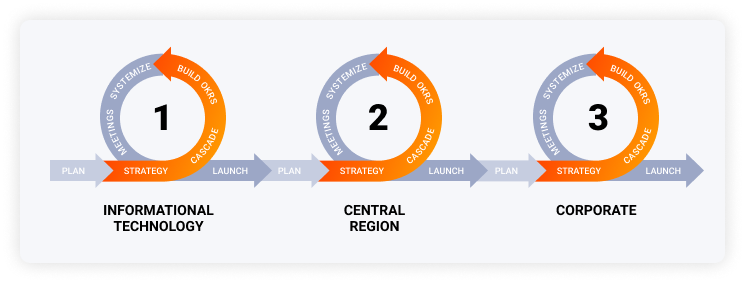Brett Knowles, pm2 Consulting
Brett is a long-time thought leader in the Strategy Execution space for high-tech organizations, beginning in the late 80’s while teaching at Harvard and being involved in the initial Balanced Scorecard research and books. His client work has been published in Harvard Business Review, Forbes, Fortune and countless other business publications.
Pub: April 6 2021
Upd: March 20 2023
The methodology for building OKRs (Objectives and Key Results) has more in common with the Scrum framework than you might think. In my opinion, much of the confusion is caused by the lexicons used in the two practices.
To restate a common phrase: OKRs and Scrum: One methodology divided by two lexicons.
Preface and caveat:
There are a few things that I want to state up-front:
1) There is no one “sanctioned” methodology for building OKRs (largely because there is no one “sanctioning authority”). OKRs are really the first “crowdsourced” management practice.
2) Unlike OKRs, there are Scrum “sanctioned” methodologies and a deep following of these steps. My references to Scrum and the terminology largely comes from the work of Jeff Sutherland and Ken Schwaber, but I recognize that organizations use different words than they proposed.
3) My consulting firm, pm2, has been using a Scrum-type approach to implementing OKR-type solutions since 1992. This article relies on the over 3,500 Scrum/OKR workshops we have run over the years.

4) I am backing up my OKR experience with what I have learned through taking most of the “OKR Certification” courses available from the various software vendors and other consultants.
All this to say, this article is based on my opinions, which many people before you have chosen to dispute! I am offering this as a thought piece, not the definitive answer.
What are the differences between OKRs and Scrum?
This article is intended to show the parallels between the Scrum framework and “common OKR building practices”. It seems to me that the similarities are uncanny, but the differences in OKRs and Scrum terminology have caused difficulties in some of our projects and key results. I’d like our learnings to be of benefit to both the Scrum and OKRs practitioners as they work together.
The terminology seems to fit into three categories:
1) Newly coined terms that are unique to either Scrum or OKRs (e.g. Scrum Master, OKR Champion, etc.)
2) Words in common use that have unique applications in either Scrum or OKR framework (e.g. Tribe, Story, Epic, etc.)
3) Words that have been in common business use for decades that have been re-defined for either Scrum or OKR (e.g. Initiative)
The above-mentioned #1 seldom causes problems, because we know that we don’t know what they mean and research what the word or title means. But #’s 2 and 3 always cause problems because we assume we know what they mean, don’t research them in this context, and find ourselves talking at cross-purposes.
What are the similarities between OKRs and Scrum?
Scrum framework terminology focuses on software development tasks. The related OKR concepts can either be for:
a) The OKR-building phase – When an organization is building their overall Objectives and Key Results for the first time.
b) Running the Business – The repeating (quarterly) cycles of updating/using/reviewing OKRs.
|
Scrum Word Guide |
OKR - Building related concept |
Running the Business OKR concept |
|
Story - AKA “user story” or “task”. Short requirements or requests written from the perspective of an End User. The job the software must do; the service it must provide to end users. For example: Desktop users need a “Home Screen” button in the top right corner. |
Functional requirements - a specific capability required within the OKR solution. For example: Ability to view OKRs by region. |
NA |
|
Sub-Task are elements that are required to enable a story. |
OKR solution design elements required to enable the required functionality. For example: Create Category Codes for each region. |
NA |
|
Epics - are large bodies of work that can be broken down into a number of smaller tasks (called stories). |
Phase - a defined sub-section of an overall initiative, usually defined by the final milestone, time-period or deliverable. In the example of OKR-building: Develop & Implement OKRs for ____ Business Unit. |
NA |
|
Initiatives - are collections of epics that drive toward common sprint goals. Example: Decrease cost of entering new markets. |
Initiatives - “Initiatives” in the management practices world typically means “a collection of projects''. Example: Decrease cost of entering new markets. In the case of OKR-building, it could be the “OKR Building” collection of projects. |
Initiatives - “Initiatives” in the management practices world typically means “a collection of projects''. Example: Decrease cost of entering new markets. In the case of OKR-building, it could be the “OKR Building” collection of projects. These may be expressed as Objectives with Key Results. |
|
Theme - Large focus areas that span the organization. |
Theme - One or more corporate-level strategic themes, such as “Pursue Operational Excellence” or “Enter New Markets” that require multiple OKRs across multiple quarters to achieve. Strategic Themes are often captured in the strategic planning cycle and documented in strategy statements. |
Theme - One or more corporate-level strategic themes, such as “Pursue Operational Excellence” or “Enter New Markets” that require multiple OKRs across multiple quarters to achieve. Strategic Themes are often captured in the strategic planning cycle and documented in strategy statements. |
|
Sprint - a fixed period, typically no longer than a month in which the work is planned, executed, and reviewed. A repeatable work cycle, also known as iteration. In by-the-book Scrum, a Sprint is 30 days long, but many scrum teams prefer shorter sprints. During the sprint, a team commits to delivering a specific set of features or sprint goals and nothing else. |
Project time horizon - the project plan for each phase of OKR implementation. |
OKR Cycle - a fixed period in which the following cycle occurs: OKR refresh/development, running the organization, OKR performance review meetings, and CFRs, period closing activities. Typically, the OKR cycle is a business quarter (three months). |
|
Minimum viable product. The first release of a product to users, which includes the absolute minimum number of features required to create value for users. |
Minimum viable product. The simplest version of the OKR solution that can be launched and used to effectively manage the organization scope. |
Minimum viable product. The simplest version of the OKR solution that can be launched and used to effectively manage the organization scope. |
|
Types of Meetings (“Events”) |
||
|
Scrum Word Guide |
OKR - Building related concept |
Running the Business OKR concept |
|
Events - the purpose of Scrum events is to ‘create regularity’ and ‘minimize the need of meetings’. These events are part of a Sprint. |
Project Governance - the project performance review meetings. |
Corporate Governance - the pre-set schedule of meetings to review organization/department/individual performance. |
|
Sprint Planning - an event to plan the stories, work, team, and timing to achieve the Spring Goal. |
Project Planning - This is a well-established role, typically filled by a certified project manager. |
NA |
|
Daily Scrum - a daily meeting to coordinate the scrum teams and apprise its members of roadblocks and risks. |
Daily Stand-Up Meeting - Daily Huddle - 10 to 20 minute meetings, typically with no chairs (hence “stand up”), in which OKR design issues of the day are dealt with. |
Daily Stand-Up Meeting - Daily Huddle - 10 to 20 minute meetings, typically with no chairs (hence “stand up”), in which OKR design issues of the day are dealt with. The Daily Huddle keeps management teams coordinated, focused, accountable and efficient. This meeting ensures everyone knows what’s going on each day. The Huddle also provides a fast way to get quick answers to any cross-functional questions. |
|
Sprint Review - an event that takes place at the end of each sprint, and is where the development team demonstrates to the stakeholders the parts of the product they completed during the sprint. |
OKR System Launch - From our experience, it is well established that no matter how much time you spend in a conference (room), you can never think your way through a great OKR solution. Like riding a bike, the only way to establish a great OKR solution is to begin riding (using) it. |
NA |
|
Sprint Retrospective - an event that occurs following the sprint review, the team holds this internal meeting where every member discusses what went well during the sprint, what didn’t work well, and how they can make improvements for the next sprint/sprint goal. |
Project Review - a review of the OKR building project covering what went well and what could be improved for the next area through the OKR building project. Update your organization’s OKR methodology. |
Quarter Closing Activities - activities done at the end of the quarter to review what performance occurred, their opportunities are, what things did not go well, etc. as learning for setting up the next quarter. |
|
Scrum of Scrums - If two scrum teams are collaborating on a single scrum project - let’s say, an in-house team, and a remote team - each may have their own scrum master. |
OKR Initiative Review - a cross-area review of if multiple areas are building their OKRs at the same time. Used to ensure consistency and deal with cross-functional OKRs. |
OKR review at different levels of the organization (department, division, corporate, etc. |
|
Progress Reporting (Artifacts) |
||
|
Scrum Word Guide |
OKR - Building related concept |
Running the Business OKR concept |
|
Artifacts - key information about the ongoing progress of the sprint that the Scrum team needs to know. The Scrum team focuses its efforts on these artifacts to ensure progress, transparency, and a shared understanding. There are three artifact products: Product Backlog, Spring Backlog, and The Increment. |
Project progress metrics |
Key Results - metrics that are associated with Specific Objectives. |
|
Product Backlog - a type of artifact that lists every element that the product requires, including product changes and their completion status. |
Project tasks - a list of the OKR building steps and the status of each one. |
NA |
|
Sprint Backlog - a type of artifact that monitors the outstanding work needed to meet the Sprint’s goal. |
NA |
|
|
Backlog - The list of user stories the team will deliver over time. It doesn’t include dates when features will launch; the team just churns through tasks over time. |
NA |
|
|
Roles |
||
|
Scrum Word |
OKR - Building related concept |
Running the Business OKR concept |
|
Stakeholder - someone - outside of the scrum roles - that is affected or impacted by the project. It may be a client, but it might also be, for example, your company’s liaison with the client, or members of another team. |
Stakeholder - someone - outside of the scrum roles - that is affected or impacted by the project. It may be a client, but it might also be, for example, your company’s liaison with the client, or members of another team. |
Stakeholder - someone - outside of the scrum roles - that is affected or impacted by the project. It may be a client, but it might also be, for example, your company’s liaison with the client, or members of another team. |
|
Product Owner - the person who represents the interests of the stakeholders. They produce the User Stories to be built. The person chiefly responsible for what the product will become, who must make hundreds of judgement calls - for instance, which features have the most business value, which opinions matter the most, and what is the minimum feature set needed to launch? This person prioritizes the work and takes both business value and tech aspects into consideration. |
Sponsor - the person who represents the interests of the stakeholders. They make sure SMEs and resources are available, help resolve any design issues. Acts as a communication bridge between the OKR project and the Stakeholders. |
OKR Champion - the person who ensures OKRs are correctly used and maintained, the standards are maintained, and that the process is continuously improved. |
|
Development Team - the team that executes all tasks. |
OKR Team - the team that actually develops the OKRs. |
NA |
|
Scrum Master - The person who facilitates the scrum process according to the Scrum framework, troubleshoots, ensures resources are available. |
OKR Champion - oversees the OKR building process, troubleshoots, ensures resources are available. Run the daily sessions, keeps the team coordinated, and ensuring that it adheres to the local methodology as much as possible. |
NA |
|
Tribe - collections of Squads working within the same business area. Example: Mobile Applications Tribe. |
NA |
NA |
|
Squads - small groups of people that own a certain part of functionality from end-to-end. AKA Scrum Team, they have a dedicated Product Owner. Example: the Search Squad. |
Teams - People who work together to work on a portion of the process of the value stream. |
Teams - People who work together to work on a portion of the process of the value stream. |
|
Chapter - a group working within a special area, such as “back office applications” which exists across several Squads. While working within their Squad, Chapter members may have a cross-squad meeting to establish common tools, approaches, interfaces, etc. |
Business Function - AKA department. People who work in the same process, usually doing a mix of different but related tasks. |
Business Function - AKA department. People who work in the same process, usually doing a mix of different but related tasks. |
|
Guild - a community of members with shared interests. These are groups of people from across the organization that want to share knowledge, tools, code and practices. Examples: Web Technology or Test Automation. |
Subject Matter Experts - (SME’s) - individuals that have deep knowledge in specific areas. |
Subject Matter Experts - (SME’s) - individuals that have deep knowledge in specific areas. |
Hopefully, this article allows you to draw parallels between the OKRs and Scrum processes, aid in agreeing to terminology in your organization, and make communication smoother between different teams.
The importance of using the correct methodology cannot be overstated - it’s just as much of a business strategy as growth marketing or technology development. Hirebook’s software empowers teams to set individual and organizational goals and have the frequent performance conversations needed to succeed.
Try Hirebook today to leverage OKRs, check-ins, and 1-on-1s to start seeing the benefits of performance management in your company.
Photo credit - peoplecreations
- Relevant
- Recent
- Topics
- Archive
- April 2023 (1)
- March 2023 (1)
- June 2022 (1)
- May 2022 (3)
- April 2022 (3)
- March 2022 (5)
- February 2022 (2)
- January 2022 (3)
- December 2021 (3)
- November 2021 (4)
- October 2021 (5)
- September 2021 (8)
- August 2021 (7)
- July 2021 (2)
- June 2021 (3)
- May 2021 (5)
- April 2021 (8)
- March 2021 (4)
- February 2021 (3)
- January 2021 (3)
- December 2020 (6)
- November 2020 (9)
- October 2020 (1)
- September 2020 (5)
- August 2020 (4)
- July 2020 (1)
Discover More Hirebook Posts










